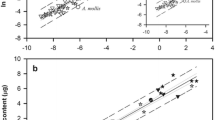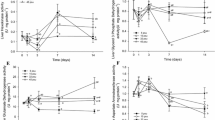Summary
The biochemical composition of developing Euphausia superba Dana embryos has been examined at three stages: fresh spawned, gastrula, and limb bud. Fresh spawn embryos had 31% lipid, 1.0% carbohydrate, and 57% protein on a gram dry weight basis. Throughout development lipids were utilized more slowly than in other crustacean embryos for a total utilization of 37.5%. Overall, 35.6% of the starting protein was utilized. On a weight basis, twice as much protein than lipid was used during development, and it appeared that, energetically, protein and lipid contributed equally to the energetics of the developing embryo. Carbohydrate was evidently a minor substrate in early development, although the level increased 38% during development. Average water content was 86% in fresh spawned embryos and 88% in the gastrula stage. The average dry weight of the embryos throughout development was 30 μg. The features of planktonic embryos are contrasted with demersal embryos and the atypical metabolic pattern of krill embryos is discussed.
Similar content being viewed by others
References
Achituv Y, Barnes H (1976) Studies in the biochemistry of cirripede eggs. 5. Changes in the general biochemical composition during development of Chthamalus stellatus. J Exp Mar Biol Ecol 22:263–267
Achituv Y, Barnes H (1978) Studies in the biochemistry of cirripede eggs. 6. Changes in the general biochemical composition during development of Tetraclita rufotincta, Balanus perforatus, and Pollicipes cornucopia. J Exp Mar Biol Ecol 32:171–176
Amsler MO, George RY (1984) Seasonal variation in the biochemical composition of Callinectes sapidus. J Crust Biol 4 (in press)
Barnes H (1965) Studies in the biochemistry of cirripede eggs. 1. Changes in the general biochemical composition during development of Balanus balanoides and B. balanus. J Mar Biol Assoc UK 45:321–339
Barnes RD (1983) Invertebrate biology. Saunders, Philadelphia
Bradford ME (1976) A rapid and sensitive method for the quantification of microgram quantities of protein utilizing the principle of protein-dye binding. Anal Chem 12:248–254
Clarke A (1980) The biochemical composition of krill Euphausia superba Dana from South Georgia. J Exp Mar Biol Ecol 43:221–236
Clarke A (1984) Lipid content and composition of Antarctic krill Euphausia superba Dana. J Crust Biol (in press)
Crisp DJ (1971) In: Holmes NA, McIntyre AD (eds) Methods for the study of marine benthos. IBP Handbook No 16. Blackwell Scientific, Oxford, pp 197–279
Folch J, Lees M, Sloane Stanley GH (1956) A simple method for the isolation and purification of total lipids from animal tissue. J Biol Chem 226:497–509
Green J (1965) Chemical embryology of Crustacea. Biol Rev 40:580–600
Holland DL (1978) Lipid reserves and energy metabolism in larvae of benthic invertebrates. In: Malins DC, Sargent JR (eds) Biochemical and biophysical perspectives in marine biology, vol 4. Academic Press, London, pp 85–123
Holland DL, Gabbott PA (1972) A micro-analytical scheme for the determination of protein, carbohydrate, lipid, and RNA levels in marine invertebrate larvae. J Mar Biol Assoc UK 51:659–668
Ikeda T (1981) Metabolic activity of larval stages of Antarctic krill. Antarct J US 17:161–162
Lasker R (1962) Efficiency and rate of yolk utilization by developing embryos and larvae of the Pacific sardine Sardinops caerulea. J Fish Res Board Can 19:867–875
Marschall H-P (1983) Sinking speed, density and size of Euphausiid eggs. Meeresforsch 30:1–9
Mauchline J, Fisher LR (1969) The biology of Euphausiids. Academic Press, New York, 454 pp
McWhinnie MA (1970) Experimental biology of krill. Inv paper SCAR/SCOR Meeting Kiel, FRG
Mengi T (1965) Veränderungen in der chemischen Zusammensetzung des reifenden Ovariums des Osteedorsches. Kiel Meeresforsch 21:107–121
Pandian TJ (1967) Changes in the chemical composition and caloric content of developing eggs of the shrimp Crangon crangon. Helgol Wiss Meeresunters 16:216–224
Pandian TJ (1970a) Yolk utilization and hatching time in the Canadian lobster Homarus americanus. Mar Biol 7:249–254
Pandian TJ (1970b) Ecophysiological studies on the developing eggs and embryos of the European lobster Homarus gammarus. Mar Biol 5:154–167
Quetin LB, Ross RM (1984) Depth distribution of developing Euphausia superba embryos, predicted from sinking rates. Mar Biol 78:47–53
Raymont JEG, Srinivasagan R, Raymont JKB (1971) Biochemical studies on marine zooplankton. 9. The biochemical composition of Euphausia superba. J Mar Biol Assoc UK 51:581–588
Van Klay H, Hale SM (1977) Assay for protein by dye binding. Anal Biochem 81:485–487
Weinstein JB, Marsh DB (1966) Simple charring method for determination of lipids. J Lipid Res 7:574–576
Author information
Authors and Affiliations
Additional information
MOA dedicates this paper to the memory of Dr. Mary Alice McWhinnie, for her encouragement during my years at DePaul University and for the opportunity to participate in her research
Rights and permissions
About this article
Cite this article
Amsler, M.O., George, R.Y. Changes in the biochemical composition of Euphausia superba Dana embryos during early development. Polar Biol 4, 61–63 (1985). https://doi.org/10.1007/BF00442901
Received:
Accepted:
Issue Date:
DOI: https://doi.org/10.1007/BF00442901




